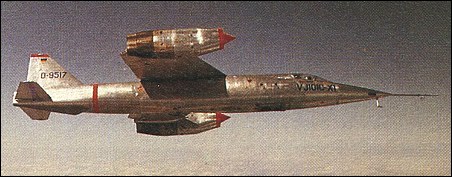 |
EWR VJ 101C1963 |  |
| VTOL AIRCRAFT | Virtual Aircraft Museum / Germany / EWR |
 |
In 1959 the design teams of the German companies Bolkow, Heinkel and Messerschmitt were formed into a consortium named Entwicklungsring Sud to develop a Mach 2 VTOL interceptor for the Federal German defence ministry. Heinkel left the consortium in 1964 and in the following year it was re-formed as a company with the title Entwicklungsring Sud GmbH, known more usually as EWR. Two prototypes of the EWR VJ 101C single-seat experimental VTOL aircraft were built. Generally similar, they were both of high-wing monoplane configuration, primarily of light alloy construction, had retractable tricycle landing gear and accommodated the pilot in a pressurised cockpit, seated on a Martin-Baker ejection seat. Powerplant comprised six RB.145 turbojets, developed jointly by Rolls-Royce and MAN-Turbomotoren, with two mounted vertically in the fuselage, immediately aft of the cockpit, and two in a swivelling pod at each wingtip. Those in the fuselage were used only for VTOL and low-speed flight, those in the wingtip pods for VTOL, low speed, transition from vertical to horizontal flight, and high-speed flight. Control of the aircraft in flight had been explored by a hovering rig powered by three Rolls-Royce RB.108 lift-jets, and by May 1963 this had made a total of 70 flights. The VJ 101C X-1 prototype was flown for the first time in free hovering flight on 10 April 1963. It had exceeded a speed of Mach 1 several times before it crashed, following a vertical take-off, on 14 September 1964. The VJ 101C X-2 differed by having afterburning engines in the wingtip pods, providing greater power for take-off and landing, and this made its first hovering flight on 12 June 1965. Four months later, on 22 October, the X-2 achieved the first full transitions from vertical to horizontal flight and vice versa, but development was discontinued soon after. Production of a single-seat interceptor was planned, under the designation EWR VJ 101D, but this would have differed considerably from the research prototypes. VTOL lift would have been retained by a battery of Rolls-Royce/ MAN RB.162 lift-jets in the fuselage, but primary propulsion would have come from two Rolls-Royce/MAN RB.153 turbofans mounted in the rear fuselage, these relying upon thrust deflection for control purposes. However, none of these aircraft was built.
|  All the World's Rotorcraft | ||||||||||||||||||||||||||||||||||||||||||
 |

|

 G Davis
G Davis
Hello John,
I am currently working on my thesis regarding Simulation of VTOL aircraft and while searching for literature found this website and your comment. I have searched for hours about technical details and information about the VJ101 and its variants, and it's a really interesting topic. I have found multiple papers form honeywell about the simulation and certain control aspects. I know this seems like a long shot, but maybe you are interested in writing /telling a bit about your work and experiences in München. Im just curious about the whole program and what it was like to be working on such a "new" and complex project with the limited possibilities of simulation /computation of that time.
Best regards,
Max
reply